As an undergraduate student researcher in the Ceramic Technology Lab and Caribbean Archaeology, much of my work involves analyzing pottery in different ways. We try to figure out information like: how was this pottery made? What is it made of? Where do we think it’s from? Often times we see pieces of pottery that appear imported, where they were found in one location but likely made in another by some other people.
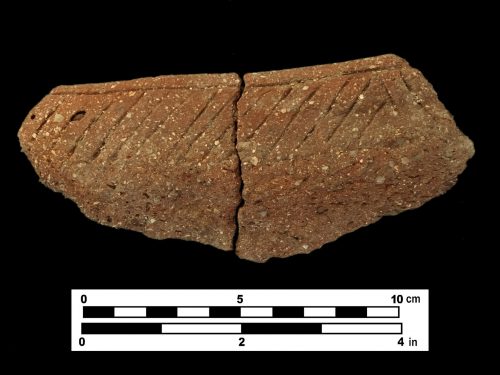
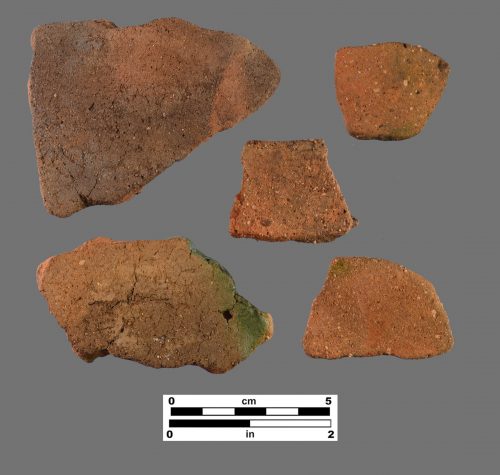
As a part of my University Scholars research project, I’ve been looking at pottery from across the Caribbean. This includes pottery and clay found in the Northern Bahamas, Southern Bahamas, and in Eastern Cuba.
As a chemistry student, I’m especially interested in information that can’t be seen with eyes alone. I want to know what elements are in these pottery pieces, also called “sherds.” I’d also like to learn more about their mineralogical composition, or how the elements form structures that give the clayey material making up the pots its softness or rigidity. For this information I use two different instruments, one is a portable x-ray fluorescence spectrometer (pXRF) and the other is an x-ray diffraction spectrometer (XRD).
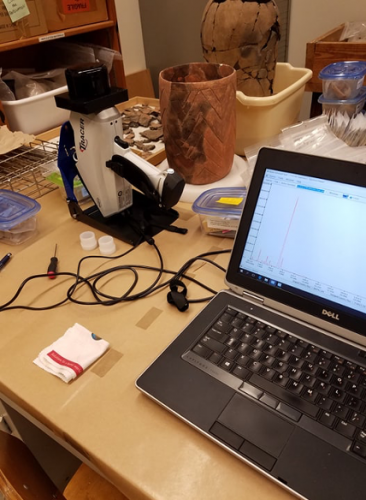
Each of these instruments requires a different level of preparation of our materials. Sample preparation for the pXRF is easy, all it requires is your pottery piece and the instrument. The pottery sherd is chipped just a little to get a fresh and clean edge. The pXRF itself looks like a laser gun. It has a place to mount and cover the samples. It bombards the pottery piece with electrons at a specific angle. When electrons are excited, they go to a higher energy state. The pXRF works by shooting the sample with these electrons and measuring the extent to which electrons fall from these energy states after losing energy, called fluorescence. We get the information in a spectrum of energy and intensity. This spectrum can be read to determine which elements may be present, and if we can find similarities or differences between our samples. Some elements we expect to see, like iron which gives our pottery that red color. We can compare elemental composition to see if where we’re finding the pottery is the same place it was being made.
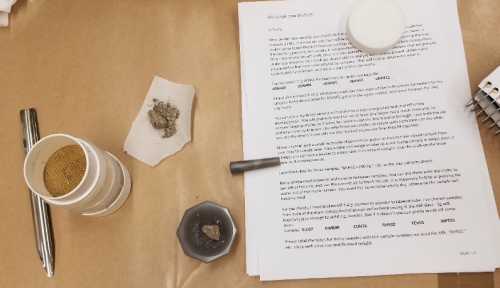
For XRD, the sample preparation is a little more complicated. Unfortunately, this method is much more destructive. I select pottery samples of three or four grams in weight each. First, I crush the sample with a small mortar and pestle. Then I put it through a small sieve, which is made of wire mesh to only allow the smallest particles through. Many of the pieces have inclusions like sand, which doesn’t break up, making it difficult to get the amount we need for analysis. We need about 2 grams for analysis.

Our sample ends up looking like this. After preparation, we took the samples to Dr. Jaeger in the the Department of Geological Sciences to prepare further and analyze with their XRD instrument. The results from this also gives us data points that we can make into a spectrum. This one uses degrees of light diffraction to help us determine what minerals are present in the sample. This could include quartz, calcite, and more. Mineralogical composition is also helpful in finding out where our pottery pieces come from and how they were made.
In the fall we will hopefully be looking at more samples from the Caribbean and using a laser ablation technique as another form of analysis.
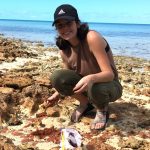 Emily Kracht (BA Anthropology, BS Chemistry, and minor in Mass Communications 2021, UF, Gainesville) began volunteering in FLMNH in February 2019 and began working in the CTL in the fall of 2019. Emily is specifically interested in the application of chemistry to archaeological materials, especially in island and coastal environments. She has done fieldwork in the Bahamas and is currently analyzing Bahamian pottery from these projects in the lab.
Emily Kracht (BA Anthropology, BS Chemistry, and minor in Mass Communications 2021, UF, Gainesville) began volunteering in FLMNH in February 2019 and began working in the CTL in the fall of 2019. Emily is specifically interested in the application of chemistry to archaeological materials, especially in island and coastal environments. She has done fieldwork in the Bahamas and is currently analyzing Bahamian pottery from these projects in the lab.